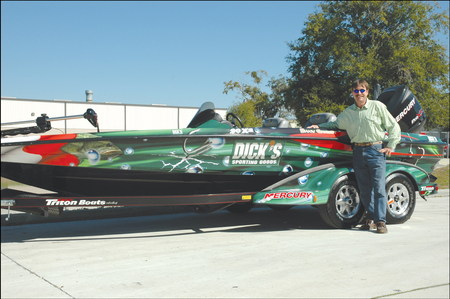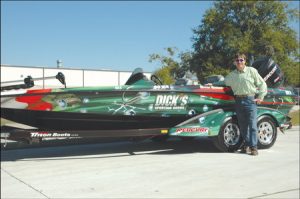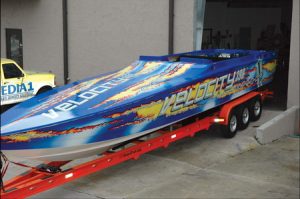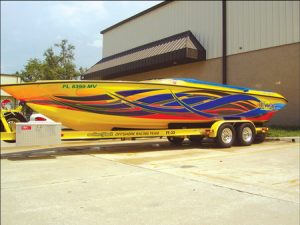Vehicles + Vinyl
Here Fishy, Fishy!
A look at the growing boat-wrap market
Published
17 years agoon

Picture yourself enjoying a quiet morning on the shore of a lake or river. Fish create ripples as they hover near the waterline; the sun has just broken the horizon, throwing a beautiful array of oranges and reds across the sky, and a hawk is circling overhead, carrying food to its young – serenity at its best.
BBBRAAHHGGH!! Forty colorful fishing boats race across the water and disrupt that bucolic scene. Professional fishermen race faster than 70 mph to their favorite spot in hopes of landing the prize catch and taking home the spoils of the weekend-long tournament. Now, that’s my idea of serenity!
Welcome to professional fishing, where boat wraps have taken center stage at U.S. tournaments. This month, we’ll look at boat wraps and what’s required to be successful in this market. I’ll share installation and fabrication experts’ insights, and fishing-tournament directors will reveal why boat wraps impact these competitions’ monetary success.
The boat-wrapping market has really exploded in recent years. Though the trend started later, it emulates the mushrooming growth of full-car NASCAR wraps (see ST, November 2006, page 104). Demand skyrocketed as professional-fishing tournaments, such as those sanctioned by BASS, FLW Series and Professional Tarpon Tournament Series (PTTS), became widely televised.
Suddenly, these weekend warriors became overnight superstars – and corporate sponsors jumped to associate their brands with them. So, let’s examine some driving factors that buoy this market segment.
AdvertisementIf you build it
Successful product launches require a receptive market. Large corporations’ marketers know how to effectively position their brands in these markets. Why? Organized sporting events, such as fishing tournaments, car races and football games, attract large live and TV audiences to a single location.
Professional fishing-tournament directors, such as PTTS founder Joe Mercurio, know how to attract corporate sponsors. He explained why boat wraps are coveted for his series.
“PTTS resembles NASCAR because all participating teams fish in the same quarter-mile square,” Mercurio said. “Boat wraps allow easy recognition of a specific team when they hook up, as well as provide a great way for them and us to promote our sponsors.”
The market’s potential? Crunch these numbers: PTTS comprises a 50-boat field and six tournaments, all of which are televised. According to the FLW website, the organization operates 12 different series, and 40 of its races are scheduled to be televised – 200 boats are eligible to enter the contests. Per its website, BASS maintains five series, with 20 televised races that lure a minimum of 50 boats. Remember, these are just the major tournaments – there are additional, regional tournaments.
According to Mercurio, tournaments and anglers drive these wraps, but non-professional fishermen are now having their boats wrapped just because the graphics are cool.
AdvertisementThe fishing-tournament market clearly exists, but please don’t limit yourself if you take the plunge (sorry, couldn’t resist). Boat-dealership owners who seek on-premise promotion, or visual communications at a boat show or race, are likely candidates for boat-wrapping services. Let’s review some key fabrication and installation points to consider before jumping in with both feet (somebody stop me!).
Gather your toolbox
At first glance, decorating a boat seems pretty basic – big, flat sides, few corrugations and no rivets – piece of cake! Sorry to bear bad news, but these jobs require detailed design, installation and material considerations that influence a successful project.
To lessen the learning curve, I interviewed market leaders to gain valuable information that’s helped them float to the top (I know, aquatic puns are getting out of hand).
Obviously, the boat-wrap process requires knowing the boat’s size and contours, and how to effectively design for its surface – the latter part presents a major challenge. I spoke with Kip Johnson, president of High Point, NC-based Motorsports Designs, who said his company spent the last seven years perfecting this art.
Advertisement“The goal is to have a complete one-piece wrap – this eliminates miscellaneous add-ons that can lift and eventually be blown off the boat,” Johnson said. “The challenge is to build in as many logos and text as possible while maintaining design integrity during the installation process.”
Johnson said Motorsports Designs devoted hours to building and developing custom templates for each boat, but, prior to printing the graphic, noted, “It’s a scary thing to see all the different angles of the logos and text.”
Another boat-wrap pioneer, Image Graphics (Ft. Lauderdale, FL), confronts similar design challenges. Wade Davis, the company president, said, “Getting an accurate template is key in designing boat wraps. Once you have an accurate template, you still have to consider how that boat will be viewed, both sitting on a trailer and sitting in the water.” This underscores the goals of sponsors bankrolling these wraps – they want logo visibility at all times on the boats’ sides.
After tackling the design phase, the next challenge is getting that graphic on the boat. Expectedly, the right tools greatly simplify your job. In this case, our tool is the media.
Johnson said his company uses different cast media and laminate manufacturers’ materials for its wraps. The manufacturer must provide a warranty for materials on boats used in both freshwater and saltwater conditions.
Johnson added, “We avoid any type of air-egress materials for water applications.” A lifted edge’s channels could act as a catalyst for rushing water to rip the graphics off during a run to the local fishing hole.
Davis said, “These boats are being seen on a national, sometimes international, stage. We can’t risk a failure, so we always use digital, cast media with a repositionable adhesive with a matching cast laminate, but no air-egress systems.”
It’s just big and flat, right?
Davis and Johnson agree suitable environmental conditions ensure a successful install. Davis said, “Having a facility that is clean and climate controlled, and provides adequate space, eliminates many problems before any vinyl is even applied.”
Likewise, Johnson said, “If the environment is too cold, it can cause the vinyl to become brittle and possibly tear, during the application process.”
Of course, surface preparation is critical. According to Johnson, the initial cleaning and prepping impact the wrap’s long-term success. Most manufacturers suggest a wipedown with isopropyl alcohol after the boat has been cleaned with soap and water, and any leftover residue has been removed. This ensures a neutralized surface and maximizes vinyl receptivity.
As Johnson previously alluded, a graphic should be installed in one complete piece. Davis said, “Using a paneling method adds more seams to the graphic and increases the chance of failure.”
Generally, team installations work best – one person can hold the graphic off the boat until the final positioning has been determined, then two or more installers can work together on each side of the boat.
Avoid wrapping the graphic where the boat will be submerged under the water line – this almost guarantees failure on the water. As with any new installation, trial and error precede perfection, but the results will justify the effort.
Making it a go
Although boat graphics have existed for several years, their popularity remains in relative infancy. For customers waffling about a boat-wrap investment, Johnson said boat wraps command attention because they’re distinct. Second, wraps protect factory-paint finishes from fading and minor scratches.
These are great selling points, but supporting your product after the sale spurs repeat customers. Mercurio said a company entering this market must “deliver a great product and provide uncompromised customer service.”
From what I’ve seen in the industry, boat wraps are corporate sponsors’ next advertising evolution. They serve a very large, dedicated audience, and a very large canvas on which to promote their products – a win-win situation for all. So, splash into the market, wiggle your bait and see what bites!

SPONSORED VIDEO
Introducing the Sign Industry Podcast
The Sign Industry Podcast is a platform for every sign person out there — from the old-timers who bent neon and hand-lettered boats to those venturing into new technologies — we want to get their stories out for everyone to hear. Come join us and listen to stories, learn tricks or techniques, and get insights of what’s to come. We are the world’s second oldest profession. The folks who started the world’s oldest profession needed a sign.
You may like

INX Promotes Three to Vice President

6 Sports Venue Signs Deserving a Standing Ovation

Hiring Practices and Roles for Women in Sign Companies
Subscribe

Bulletins
Get the most important news and business ideas from Signs of the Times magazine's news bulletin.
Most Popular
-

 Tip Sheet3 days ago
Tip Sheet3 days agoAlways Brand Yourself and Wear Fewer Hats — Two of April’s Sign Tips
-

 Business Management2 weeks ago
Business Management2 weeks agoWhen Should Sign Companies Hire Salespeople or Fire Customers?
-

 Women in Signs2 weeks ago
Women in Signs2 weeks ago2024 Women in Signs Award Winners Excel in Diverse Roles
-

 Real Deal4 days ago
Real Deal4 days agoA Woman Sign Company Owner Confronts a Sexist Wholesaler
-

 Editor's Note1 week ago
Editor's Note1 week agoWhy We Still Need the Women in Signs Award
-

 Benchmarks14 hours ago
Benchmarks14 hours ago6 Sports Venue Signs Deserving a Standing Ovation
-

 Line Time2 weeks ago
Line Time2 weeks agoOne Less Thing to Do for Sign Customers
-

 Product Buying + Technology1 week ago
Product Buying + Technology1 week agoADA Signs and More Uses for Engraving Machines
















